Site Navigation:
Searchable Databases
Articles Archive
Pacific Nautical Heritage...
- Gallery of Light and Buoy Images
- Gallery of Mariners
- Gallery of Ship Images
- Gallery of Ship Wrecks
- Gallery of Monuments and Statues
- Gallery of Nautical Images
- Gallery of Freshwater Images
- Gallery of New Books
Canadian Naval Topics…
- Nautical History Videos
- UNTD
- British Columbia Heritage
- Arctic and Northern Nautical Heritage
- Western Canada Boat and Ship Builders
- Gallery of Arctic Images
- Reflections on Nautical Heritage
- British Columbia Heritage
Site Search:
Looking for more? Search for Articles on the Nauticapedia Site.
The Perfect Job
Marine Pilot Captain Steven Kennedy
by Lynn J. Salmon 2021

"What's the fastest moving object in the world?" I'm interviewing Captain Steven Kennedy by phone and I hear the tone of his question along the lines of a knock-knock joke. I buy in; I tell him: I don't know the answer. "An almost stopped ship." From a marine pilot's perspective, that is the critical difference between completing a job with success or meeting the company lawyer.
I had the pleasure of meeting Captain Kennedy onboard Pacific Pilotage Authority pilot boat Pacific Pathfinder in July 2017. My husband Dan and I were riding along as guests, outbound to the pilot-boarding station at Triple Island to meet the 30,277 gross tonnage, 824-passenger ship Regatta. Captain Kennedy was tasked with piloting the ship to the cruise ship dock at Atlin Terminal in Prince Rupert Harbour. As we approached the Regatta, her pilot-boarding door open with crew standing by to assist, Kennedy donned a lifejacket and prepared to step onto the deck. The skipper of the pilot boat skilfully manoeuvred towards the ship, the rubbing strake touching lightly as Kennedy grabbed the thin rails either side of the pilot door to hoist himself aboard. Pathfinder then broke away and returned to the dock at Fairview. Regatta arrived a few hours later but I wondered, ever since that trip, just what Captain Kennedy had to do to bring Regatta into the dock. I finally asked him three years later.


Captain Steven Kennedy has always been around water. His father, Skip Kennedy, tried his hand at fishing in the fifties crewing from the deck of the double-ended troller Blue Pacific. He had been a logger previously and, after the brief interlude commercial fishing, went back to logging. The family lived in Haida Gwaii (formerly the Queen Charlottes) before eventually settling in Metchosin on 3.5 acres. With Steven carried aboard in a basket, Skip and his wife Elva often enjoyed being on the water while sport fishing and naturally, Steven found his sea legs early.
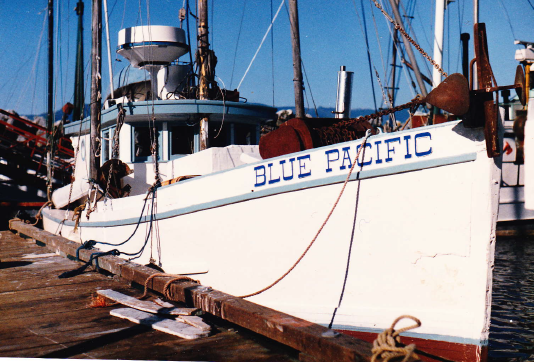



From left: Young Steven fishing with dad and sister 1970; bringing in the catch; the present-day Kennedy family on the water. (Captain Steven Kennedy photos)
Right out of high school, at the age of eighteen, he went to sea with a career in mind. "I grew up on the coast, on and around water, listening to dad's stories." It became his goal to captain a fish boat. While he enjoyed his time working on the fish boats, he wasn’t getting steady work. "An opportunity came up to sail on a Gulf of Alaska research trip, aboard the CSS John P. Tully in May 1987: I jumped at it!" Kennedy continued to accept marine-based work that took him around the world. He was seeking a challenge, adventure and excitement. His early mentor was Brian Watt who worked as an Engineer on the DFO ship Tanu. "He encouraged me to follow that route. I applied at IOS for a deckhand position. The bulk of my early years were on the Parizeau." Kennedy spent the next fifteen years learning skills and seeing a lot of ocean offshore. "When the weather ships [Vancouver and Quadra] were shut down and came in from Station Papa, the Parizeau was spending several months every year out in those waters for science tasking."

The Parizeau did all kinds of interesting science work. "Oceanography, drift buoys, subsurface mooring buoys with sediment traps and current meters; different science groups from around the world, each with their own experiments to conduct." The work was never boring and took him offshore as well as to the far north. "On the Laurier, headed for the Arctic—I've been there six times—on one passage we carried a bunch of bottles with a note inside them and tossed them in the ocean every couple hours from the northern tip of Vancouver Island to Unimak Pass hoping they would be reported when found." Kennedy fulfilled many roles on board the Laurier; first as 3rd mate, then 2nd and then Chief Officer. He spent those years learning the many skills of a mariner and setting a new goal: to take on one of the most complex positions afloat as marine pilot.
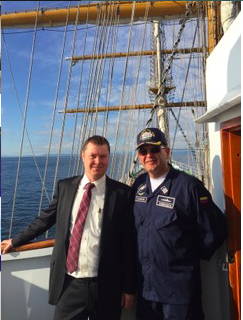
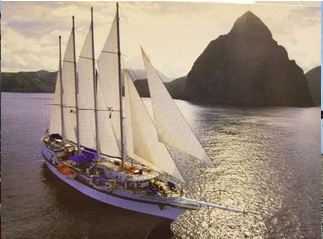
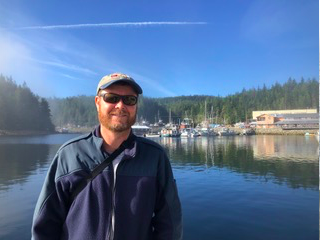
From left: On board the Colombian Naval training barque Gloria with Captain Garcia May 9, 2017; tall ship Legacy, off the Pitons, Saint Lucia, where Kennedy sailed as Chief Officer 2001 (and met wife Linda); and at Shearwater August 2019 on a family boating trip to Haida Gwaii. (Captain Steven Kennedy photos)
History of Pilotage
Sailing ships inbound for Vancouver in the mid-1800s had to rely on whatever boat reached them first and then barter terms for pilotage into harbour waters. These boats were of various shapes and sizes and waited at Pilot's Cove, fittingly named, in order to spot the top-masts of inbound ships. Then, the race was on. Kennedy continues with relating this history. "On heavy weather days, the heavier boats would arrive first. On calm days, the smaller craft. The captain on the inbound vessel would negotiate the terms and where they wanted to go and there was no regulation. Each deal was unique. In 1858, the government took over pilotage and licensing and the first licence, number 001, was issued to Captain Henry Glide." This mariner had arrived on the Pacific coast from England in 1853.
In 1972 the government wanted to maintain control over licensing while at the same time rid themselves of the management of the daily operations so the pilots formed a private entity: The BC Coast Pilots Ltd. (BCCP). They maintain relationships with stakeholders and provide critical input on regulatory issues such as conferring with coast guard on the placement, and the continuing use, of aids to navigation. The Pacific Pilotage Authority (PPA) handles the logistics for travel arrangements and dispatching pilots for work and also oversees the running of the pilot boats and their masters and crew. The BCCP are contracted by PPA to do the ship handling - the piloting. "The BC Coast Pilot Ltd is self-sufficient. The PPA sets the tariff for shipping based on a formula, and then the PPA contracts The BC Coast Pilot Ltd to service the ships and all of it is funded directly from the tariffs paid by the ships. It's a user-pay system that is envied around the world. The Canadian public is well-served by the pilotage system."
There are unique pilotage regions across Canada. British Columbia has the largest in the nation, and also worldwide, while back east there are the Laurentian, Great Lakes, Upper/Lower St. Lawrence, and Atlantic regions. Currently there is a movement by the Federal Government to transfer the regulatory aspect of pilotage under the auspices of Transport Canada and there is concern that local knowledge and unique industry relationships will be lost with the transfer to a centralized office in Ottawa. No one is certain how this will play out and there is reluctance to add yet another layer of government to the pilotage system.
The BC Coast Pilots Ltd.
The BCCP mandate sums up their work: 'From Alaska to the southern Canadian border, under the Pilotage Act, we are mandated to board and guide any foreign ship coming in or out of BC’s ports for safety, efficiency and environmental protection.'


I asked Kennedy what it takes to become a BC coast pilot and uphold that mandate. "Our company takes what we feel are the best people from all industries on the coast who qualify." Not everyone who aspires for pilot makes it but along the way they are ever-striving to be the best mariner possible. As for companies who lose people to the program, a senior executive from one of the tug companies told Kennedy it really is in everyone's interest to support their goal. "It will take about five years to become successful, and during that time [the tug company] will have a model employee who really doesn’t want to have any blemishes on his record, which means no accidents or issues of any kind. Furthermore, that employee is studying the coast and really learning how the tides and currents affect different locations at different states of the tide, where the dangers are and how to avoid them, which makes for a better mariner with deeper coastal knowledge." Kennedy stresses that the work put in beforehand is paramount to success. "You have to be able to describe any passage or approach on the coast before you will be successful. This includes all the aids to navigation and shore features, wind and current tendencies, all the danger that exists around the ship, including up to the 20-metre contour, of all the rocks and shoals. You have to be able to describe the passage as though you are looking out the bridge windows."


The view from the bridge: (L) approaching the Ironworkers Memorial Bridge westbound, aboard Santa Graciela, May 28, 2018 at Second Narrows and (R) approaching Fairview Terminal at Prince Rupert aboard the COSCO Korea waiting for the outbound to depart, July 30, 2017. (Captain Steven Kennedy photos).
As ships have become increasingly larger, the apprentice portion, which first started in 1976, has lengthened from six months to nine. Kennedy recalls this as the halcyon moments of training. "Being an apprentice is the best time as you get to go all over the coast with ship movements into all the different ports. You get to ride along on all the different jobs and you gain knowledge unique to that port. It's really an incredible opportunity because you have to be able to know, to draw, to describe the coast in very high detail before you can write the exam. All your prior experience on ships, whether fishing boats, tugs, ferries, all of that is good to get the basics. Then, as an apprentice, you learn how to ship handle, berthing the ship, working with tugs, driving the ship around the coast. Nothing you have done previously can fully prepare you for being a pilot, without going through the apprentice program."
Kennedy has worked since 2010 at his career as a BC Coast pilot with 1200 successfully completed ship movements. "I have a job working at sea that I can work from home. Of the 115 members in the company, 40% work out of Victoria (five are based in Nanaimo) and the other 60% work from Vancouver." When asked what he best likes about the job his answer is quick: "So much to like." With a moment of reflection he elaborates on a personal level. "It's been satisfying because it takes a long time to get here [licenced pilot]. In my mid-twenties I set the goal and I have the satisfaction of achieving it." As for the work itself: "The job is different every day, never knowing when you're working, though it's often at night when ship movements are common. You're on different ships like bulkers, cruise ships, container ships, and every one handles differently and every one has a different crew." He tells me that world politics often have to take a back seat to the running of a ship. "It can get super interesting when the Captain is Russian and the first mate is Ukrainian and you see the dynamics of that with the current political situation in the world." And the work he doesn't like? "Nothing that I don't like. Sometimes 'Midnight to sea' can be tough. All night on a slow heavy outbound to the pilot station, those are the tough ones. But once I'm on the ship, I'm dialled in and focused. You have to be prepared for really abstract hours of work and catch sleep when you can."
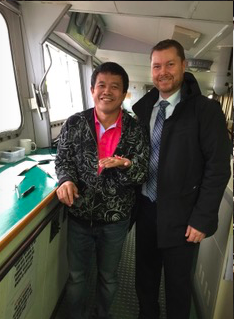

On board the Milagro departing Roberts Bank Coal bound for the pilot station. The Captain is holding a paper crane. (R) "My daughter Aria makes them to give to the Captains of all the ships I board. She wants the Captains to have the crane as they are away from their families for months at a time and the crane symbolizes happiness and peace."
(Captain Steven Kennedy photos)

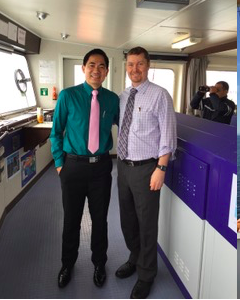
I recall from our brief ride out to Triple Island in 2017 that Kennedy carried a shoulder bag with him. "You're living out of your suitcase and I'm a minimalist so I carry as little as possible. You do a lot of flying in this career and my bag weighs 16 pounds. I know some guys who cart around 24 pounds. As a pilot, it seems you have embarked on a career of finding the perfect bag to carry." With it, he takes on board the Personal Pilotage Unit, known as the PPU, consisting of a Panasonic tough pad, rate of turn generator (ROT) and GPS, as well as a tide book, source cards, VHF handheld, pilots licence, dock plans for the entire coast, phone charger, sunglasses, noise-cancelling ear buds, toothbrush and toothpaste, pens, rain pants, a list of all nchoring positions on the coast with ranges and bearings for each, aspirin, and a newspaper for the captain.
The ROT generator plugs directly into the ships AIS and then displays the AIS targets on the PPU. The ROT is displayed numerically as well as a vector ahead of the ship. "With fully laden ships it’s important to keep the rate of turn low because when heavy ships start turning, it can be very difficult to stop them."
Other tools of the trade, those that are not carried aboard, are the numerous beacons and aids to navigation that are indispensable visual points of reference. Pilots "absolutely rely on them" even though ships are equipped with electronics. "It is essential, when moving a ship, to be able to identify your clearing lines. The PPU is strictly to support what we see out the window and secondary to our knowledge needed to drive the ship around without electronics. Of course in reduced visibility, there is a heavier reliance on the PPU equipment we carry, as well as the ships radar."


Kennedy using manned models at the Port Revel training facility (L) June 9, 2017 (R) April 29, 2013 (Captain Steven Kennedy photos)
Using manned models and simulators are an important component of training. Simulator facilities include Canada's Quebec City, and Seattle and Baltimore in the US. Manned model facilities include Southampton in the UK and Port Revel in France. The BCCP "chooses the best training available" and facilities stay up-to-date with not only the size of vessels by building post-Panamax models and Voyager-class cruise ships but also with how they move by installing azipod propulsion systems on the models. Port Revel, for instance, has a five-hectare lake and twelve manned models—1:25th scale exact replicas representing 23 different ship types—to provide realistic ship handling.

In Vancouver the marine pilot training simulator is jointly owned by both the PPA and BCCP and gets used extensively. "We do a lot of simulator training in Second Narrows to prepare us for failures such as electronics, engine or rudder. With the tug packages, and the training we have we are able to stop the ship when a failure occurs, or if we are past the point of no return, we are still able to safely move the ship using the tugs for power and steerage. The simulator is also used for new berths prior to the infrastructure being built, ensuring the new terminals will be safe to bring ships into and out of."
Dispatching the Jobs
All pilot-compulsory vessels have their agent contact PPA. The pilot is sent an email with the job details and he reviews all the information. "I look at the job, note the size of the ship, how heavy it is, check the tides and currents, note the berth either on, off or both if shifting from one berth to another and base that information on what tug power I will require to safely complete the job. I then phone the tug company listed on that job and order the specific tugs I require. Then I make all transportation arrangements I’ll need to get to and from the job. This can include water taxis, and ground transportation, flights and hotels. From the time I’m dispatched, I’ll complete this prep work and be on the bridge of the ship in under three hours. For jobs at Fraser Surrey, Roberts Bank or Delta Port it’s four hours and if you require a flight the lead-time depends on the flight time. Generally fixed wing flights from YVR and hotels are pre-booked by the PPA dispatcher."



All in a day's work: boarding via helicopter hoist, the pilot boat, and accommodation ladder alongside. (L photo Dan Salmon, upper and middle photos Captain Steven Kennedy )
Getting on board a ship can be tricky whether via pilot boat, helicopter, ships ladder or accommodation ladder. Pilots take specialized training for helicopter deployment in Arizona, the same that is required of oil workers for Gulf of Mexico rigs. Energy projects, such as those developing at Kitimat, will require pilots to board vessels six miles west of Triple Island, the official northern waters pilot boarding station. Those assignments will necessitate delivery via helicopter as sea conditions can be treacherous and make it especially dangerous for boarding by pilot ladder, a vertical drop on average, of nine metres.

Windage Happens
Kennedy tells me that container ships generally handle well until they get slowed down, unlike loaded bulk carriers that are sixty-feet under water so wind has less affect on them. Taking a ship to Deltaport is stressful work when the wind is blowing. "It's generally from the southeast and hitting on the beam with containers up to the bridge windows, and well, that's a lot of windage to take into consideration." One such tasking was the fully stacked containership Al Quiba. Kennedy asked the captain "What's the wind area" and he responded with a number in square metres. "I converted it to square feet and it was just a big number. So I converted it again, and came up with almost 5 acres. The Metchosin property is 3.5 acres so now it made sense. I checked the scale—the size of the wind area against the strength of the wind—and it gave me the force on the ship of 100 tonnes. Now you can assess how effective your tug package will be." Even so, it isn't straightforward. "That should mean ordering two tugs capable of pulling 50 tons. But really, it all comes down to the bitts on the ship and if those are rated to 33 or 40 tons, then a tug pulling 50 tons can rip that bitt right off the deck so now I need three 50 ton tugs for 100 tonnes of force because the bitts are rated much lower."
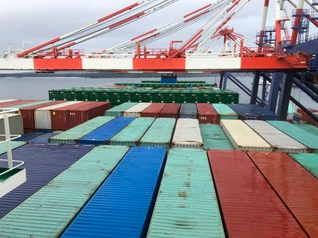
Every Day Different
Every pilot order is different and comes with its own unique challenges. The biggest container ships he has brought in are the 366m class which are regular callers into DelatPort and Prince Rupert. These ships are too large to come directly into Vancouver Harbour. Some of the cruise ships calling on the port are so large they have retractable masts yet still require low water to fit under Lions Gate Bridge.
The job of the marine pilot is one full of challenge, knowledge and skill. Captain Steven Kennedy tells me he wouldn't trade this career for any other. "I started out seeking adventure and excitement with my earlier years of work and I've ended up in a career with the sole purpose of having boring days without any moments of excitement. For me, that's the perfect job."
In July 2020 Captain Kennedy was elected into the Vice President position for the BCCP. "It’s exciting and challenging and very different from piloting ships. For the first time in my life I now work in an office."
I have no doubt Captain Kennedy will apply the same level of dedication and professionalism to this new role, and continue to serve the Canadian public, keeping our waters safe for decades to come.
To quote from this article please cite:
Salmon, Lynn J. (2021) The Perfect Job Nauticapedia.ca 2021. http://nauticapedia.ca/Gallery/Kennedy_Steven.php

Site News: April 13th, 2025
ANOTHER MILESTONE REACHED
The vessel database has been updated and is now holding 95,413 vessel histories (with 16,500 images and 14,326 records of ship wrecks and marine disasters).
The mariner and naval biography database has also been updated and now contains 58,599 entries (with 4,006 images).
My thanks to Ray Warren who is beginning a long process of filling gaps in the photo record of the vessel histories in the vessel database. Ray has been documenting the ships of Vancouver Harbour for more than 60 years.
Thanks to contributor Mike Rydqvist McCammon for the hundreds of photos he continues to contribute to illustrate British Columbia’s floating heritage.
My very special thanks to our volunteer IT adviser, John Eyre, who (since 2021) has modernized, simplified and improved the update process for the databases into semi–automated processes. His participation has been vital to keeping the Nauticapedia available to our netizens.
Thanks to John Spivey who is in his 4th year of fact checking all of the entries in the vessel database, one-by-one.